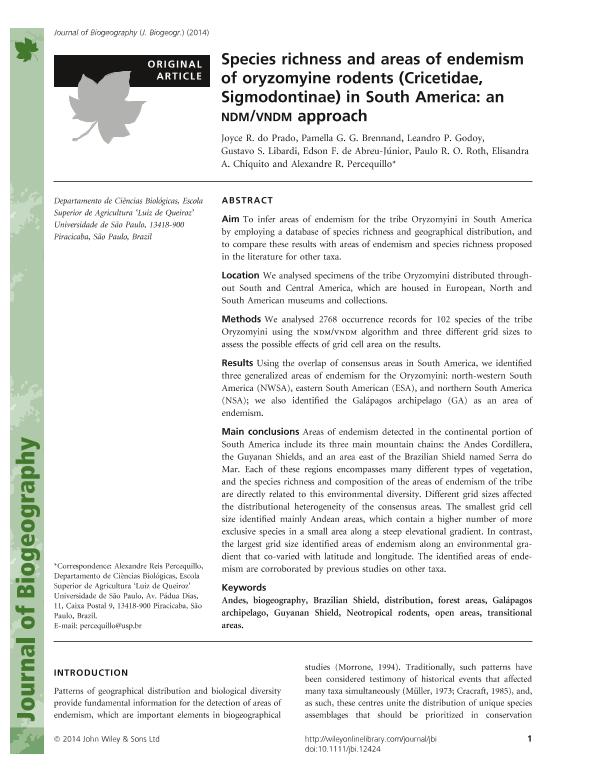Mostrar el registro sencillo del ítem
dc.contributor.author
do Prado, Joyce R.
dc.contributor.author
Brennand, Pamella G. G.
dc.contributor.author
Perez Godoy, Leandro
dc.contributor.author
Simoes Libardi, Gustavo

dc.contributor.author
de Abreu Junior, Edson Fiedler
dc.contributor.author
Roth, Paulo R. O.
dc.contributor.author
Chiquito, Elisandra A.
dc.contributor.author
Percequillo, Alexandre R.
dc.date.available
2017-08-18T19:57:47Z
dc.date.issued
2014-11-04
dc.identifier.citation
do Prado, Joyce R.; Brennand, Pamella G. G.; Perez Godoy, Leandro; Simoes Libardi, Gustavo; de Abreu Junior, Edson Fiedler; et al.; Species richness and areas of endemism of oryzomyine rodents (Cricetidae, Sigmodontinae) in South America: an NDM/VNDM approach; John Wiley & Sons Ltd; Journal Of Biogeography; 42; 3; 4-11-2014; 540-551
dc.identifier.issn
0305-0270
dc.identifier.uri
http://hdl.handle.net/11336/22703
dc.description.abstract
Aim. To infer areas of endemism for the tribe Oryzomyini in South America by employing a database of species richness and geographical distribution, and to compare these results with areas of endemism and species richness proposed in the literature for other taxa. // Location. We analysed specimens of the tribe Oryzomyini distributed throughout South and Central America, which are housed in European, North and South American museums and collections. // Methods. We analysed 2768 occurrence records for 102 species of the tribe Oryzomyini using the NDM/VNDM algorithm and three different grid sizes to assess the possible effects of grid cell area on the results. // Results. Using the overlap of consensus areas in South America, we identified three generalized areas of endemism for the Oryzomyini: north-western South America (NWSA), eastern South American (ESA), and northern South America (NSA); we also identified the Galápagos archipelago (GA) as an area of endemism.// Main conclusions Areas of endemism detected in the continental portion of South America include its three main mountain chains: the Andes Cordillera, the Guyanan Shields, and an area east of the Brazilian Shield named Serra do Mar. Each of these regions encompasses many different types of vegetation, and the species richness and composition of the areas of endemism of the tribe are directly related to this environmental diversity. Different grid sizes affected the distributional heterogeneity of the consensus areas. The smallest grid cell size identified mainly Andean areas, which contain a higher number of more exclusive species in a small area along a steep elevational gradient. In contrast, the largest grid size identified areas of endemism along an environmental gradient that co-varied with latitude and longitude. The identified areas of endemism are corroborated by previous studies on other taxa.
dc.format
application/pdf
dc.language.iso
eng
dc.publisher
John Wiley & Sons Ltd

dc.rights
info:eu-repo/semantics/openAccess
dc.rights.uri
https://creativecommons.org/licenses/by-nc-sa/2.5/ar/
dc.subject
Andes
dc.subject
Biogeography
dc.subject
Brazilian Shield
dc.subject
Distribution
dc.subject
Forest Areas
dc.subject
Galápagos Archipelago
dc.subject
Guyanan Shield
dc.subject
Neotropical Rodents
dc.subject
Open Areas
dc.subject
Transitional Areas
dc.subject.classification
Zoología, Ornitología, Entomología, Etología

dc.subject.classification
Ciencias Biológicas

dc.subject.classification
CIENCIAS NATURALES Y EXACTAS

dc.title
Species richness and areas of endemism of oryzomyine rodents (Cricetidae, Sigmodontinae) in South America: an NDM/VNDM approach
dc.type
info:eu-repo/semantics/article
dc.type
info:ar-repo/semantics/artículo
dc.type
info:eu-repo/semantics/publishedVersion
dc.date.updated
2017-07-20T14:21:13Z
dc.identifier.eissn
1365-2699
dc.journal.volume
42
dc.journal.number
3
dc.journal.pagination
540-551
dc.journal.pais
Estados Unidos

dc.journal.ciudad
Hoboken
dc.description.fil
Fil: do Prado, Joyce R.. Universidade Do Sao Paulo. Escola Superior de Agricultura Luiz de Queiroz Esalq; Brasil
dc.description.fil
Fil: Brennand, Pamella G. G.. Universidade Do Sao Paulo. Escola Superior de Agricultura Luiz de Queiroz Esalq; Brasil
dc.description.fil
Fil: Perez Godoy, Leandro. Universidade Do Sao Paulo. Escola Superior de Agricultura Luiz de Queiroz Esalq; Brasil
dc.description.fil
Fil: Simoes Libardi, Gustavo. Universidade Do Sao Paulo. Escola Superior de Agricultura Luiz de Queiroz Esalq; Brasil. Consejo Nacional de Investigaciones Científicas y Técnicas. Centro Científico Tecnológico Conicet - Centro Nacional Patagónico; Argentina
dc.description.fil
Fil: de Abreu Junior, Edson Fiedler. Universidade Do Sao Paulo. Escola Superior de Agricultura Luiz de Queiroz Esalq; Brasil
dc.description.fil
Fil: Roth, Paulo R. O.. Universidade Do Sao Paulo. Escola Superior de Agricultura Luiz de Queiroz Esalq; Brasil
dc.description.fil
Fil: Chiquito, Elisandra A.. Universidade Do Sao Paulo. Escola Superior de Agricultura Luiz de Queiroz Esalq; Brasil
dc.description.fil
Fil: Percequillo, Alexandre R.. Universidade Do Sao Paulo. Escola Superior de Agricultura Luiz de Queiroz Esalq; Brasil
dc.journal.title
Journal Of Biogeography

dc.relation.alternativeid
info:eu-repo/semantics/altIdentifier/doi/http://dx.doi.org/10.1111/jbi.12424
dc.relation.alternativeid
info:eu-repo/semantics/altIdentifier/url/http://onlinelibrary.wiley.com/doi/10.1111/jbi.12424/abstract
Archivos asociados
